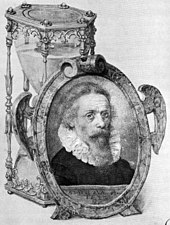Georg Flegel

Georg Flegel (* 1566 in Olomouc ; † March 23, 1638 in Frankfurt am Main ) was an important still life painter of the early 17th century.
life and work
Born in 1566 in Olomouc in Moravia, probably the son of a shoemaker, Flegel worked at a time when the depiction of inanimate objects was only slowly emerging from the background of portraits and scenic representations. Flegel painted still lifes of flowers, birds and smokers as well as those of meals, confectionery and delicacies . Some nature studies in watercolor are also part of his work.
From the eighties of the 16th century he worked as a "sculptor" in the Linz workshop of the Dutch painter Lucas van Valckenborch . His job was to large-format paintings of table companies or market scenes with fruits, vegetables and flowers auszustaffieren . Around 1592/93 van Valckenborch moved his workshop to Frankfurt am Main, where Flegel followed him and worked as a freelance painter until his death in 1638.
His wife Brigitta had also come to Frankfurt with Flegel. In 1594, Martin, the couple's firstborn son, was baptized. On April 28, 1597, Flegel received citizenship in Frankfurt, which was made possible by a good report from van Valckenborch. Around 1600 Flegel began to devote himself to the emerging genre of still life. In this genre he covered a variety of subjects. Repetitions and adopting motifs suggest that he sometimes also worked according to economic aspects. In contrast to his teacher van Valckenborch, however, Flegel was not found to be a larger company with journeymen and assistants who shared the labor . Georg Flegel's only pupil was Jacob Marrel , born in 1614 , who later studied with Jan Davidszoon de Heem in Utrecht .
Georg Flegel had seven children, all of whom he - like his wife († probably 1633) - survived. Two of his sons, Friedrich (1596 / 97–1616) and Jacob († 1623; probably identical to Leonhard, * 1602), were also painters.
Although Sebastian Stoskopff was influenced by Flegel in the arrangement of the composition , it is not known whether he had known Flegel during his lifetime or whether he only saw the works after Flegel's death. Furthermore, the influence seems to have been “rather sporadic and not permanent”.
In 2009 , the Deutsche Post published a stamp in honor of Flegels as part of the German Painting series . It has a face value of 45 cents and was designed by Werner Hans Schmidt .
literature
- Wolfgang J. Müller: Flegel, Georg. In: New German Biography (NDB). Volume 5, Duncker & Humblot, Berlin 1961, ISBN 3-428-00186-9 , p. 230 ( digitized version ).
- Kurt Wettengl: Georg Flegel (1566 - 1638), still life . [Publication for the exhibition "Georg Flegel (1566 - 1638), Stilleben" of the Historisches Museum Frankfurt am Main in cooperation with the Schirn Kunsthalle Frankfurt from December 18 to February 13, 1994] Verlag Hatje, Stuttgart 1993, ISBN 3-7757-0472 -8th
- Anne-Dore Ketelsen-Volkhardt: Georg Flegel. 1566-1638 . Deutscher Kunstverlag, Munich / Berlin 2003, ISBN 3-422-06378-1
Individual evidence
- ↑ Sabine Schulze (Ed.): Gardens: Order - Inspiration - Luck , Städel Museum , Frankfurt am Main & Hatje Cantz Verlag, Ostfildern 2006, ISBN 978-3-7757-1870-7 , p. 48
- ↑ Michèle-Caroline Heck: The influence on Sebastian Stoskopff in Kurt Wettengl: Georg Flegel (1566 - 1638), still life: [Publication for the exhibition "Georg Flegel (1566 - 1638), still life" of the Historical Museum Frankfurt am Main in cooperation with the Schirn Kunsthalle Frankfurt from December 18 to February 13, 1994] . Hatje, Stuttgart 1993, ISBN 3-7757-0472-8
- ^ Deutsche Post: Series "German Painting": Georg Flegel - Still Life with Cherries , accessed on September 3, 2010
Web links
- Works by Georg Flegel at Zeno.org .
- Literature by and about Georg Flegel in the catalog of the German National Library
| personal data | |
|---|---|
| SURNAME | Flegel, Georg |
| BRIEF DESCRIPTION | German still life painter |
| DATE OF BIRTH | 1566 |
| PLACE OF BIRTH | Olomouc |
| DATE OF DEATH | March 23, 1638 |
| Place of death | Frankfurt am Main |


